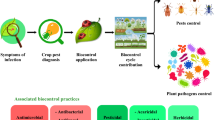Abstract
The effects of fungicides containing mancozeb or copper oxychloride, as principal active ingredients, on phytoseiid mites were investigated in a vineyard comprising four varieties (Prosecco, Cabernet Franc, Pinot gris and Merlot) and located in north-eastern Italy. Phytoseiid colonisation was different among the four varieties: Amblyseius andersoni and Kampimodromus aberrans were dominant on Pinot gris and Merlot, respectively, while Typhlodromus pyri was more common than the above species on Prosecco and Cabernet Franc. Applications of mancozeb fungicides significantly affected K. aberrans populations. Concerning T. pyri, a significant effect was observed on Cabernet but not on Prosecco. The effects of mancozeb fungicides on A. andersoni were less clear. The response of phytoseiids to fungicides containing mancozeb appeared to be mediated by the variety. Therefore, the choice of one or two varieties as a standard reference for field tests is recommended. These results also suggest that the side effects of fungicides on predatory mites should be studied on different phytoseiid species and, possibly, on susceptible and resistant strains in order to gain useful insights.
Similar content being viewed by others
Author information
Authors and Affiliations
Corresponding author
Rights and permissions
About this article
Cite this article
Pozzebon, A., Duso, C. & Pavanetto, E. Side effects of some fungicides on phytoseiid mites (Acari, Phytoseiidae) in north-Italian vineyards. Anzeiger für Schädlingskunde/J. Pest Science 75, 132–136 (2002). https://doi.org/10.1046/j.1472-8206.2002.02037.x
Issue Date:
DOI: https://doi.org/10.1046/j.1472-8206.2002.02037.x




